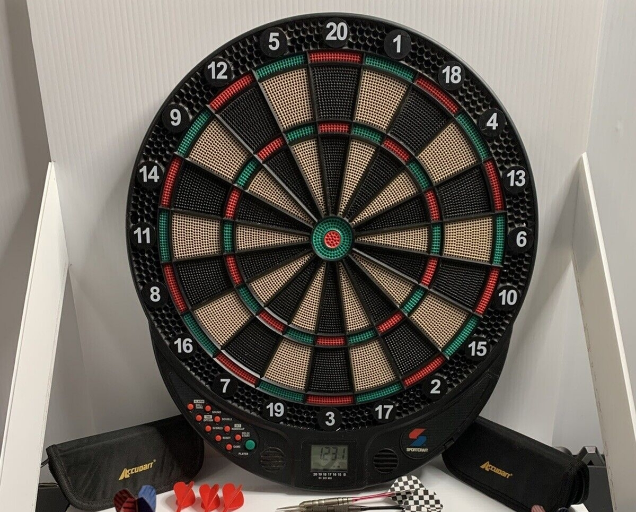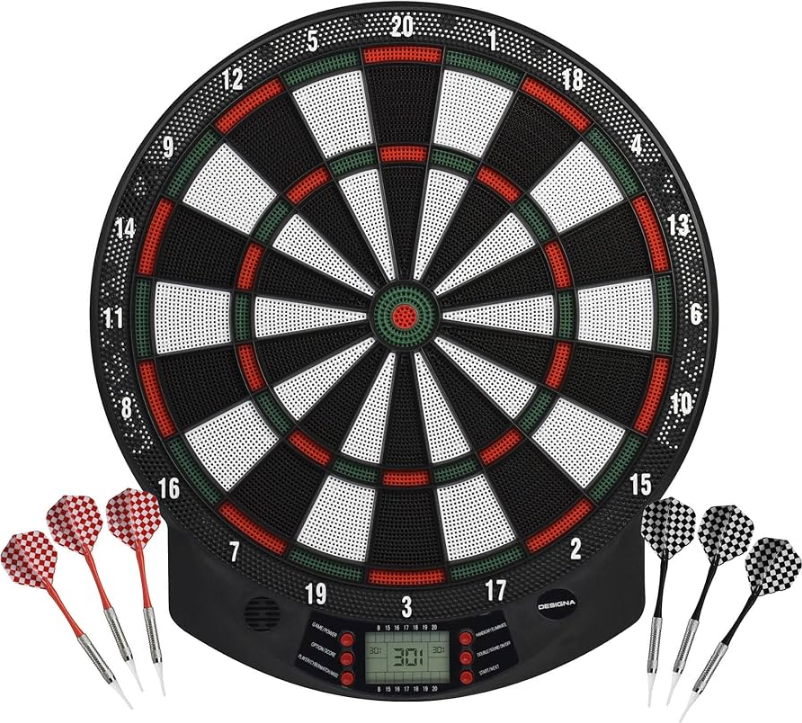
Accudart eX3000 Electronic Dartboard Game
MOUNTING INSTRUCTION
Choose a location to hang the dartboard where there is about 10 feet of open space in front of the board. The “toe-line” should be 7‟ 9 1/4” from the face of the dartboard. Locate a wall stud and place a mark 74-3/4 inches from the floor. This mark is for the top screw hole. For the bottom two screws, you will measure down 15 inches from the top mark you just made (59-3/4 inches from the floor).
Insert mounting screws in the center of the marks you made. Mount the dartboard on the wall by lining up the holes on the back with the screws. It may be necessary to adjust the screws until the board fits snugly against the wall. Center of Bullseye should be 5’ 8” from the floor when finished.

DARTBOARD FUNCTIONS
BUTTONS FUNCTION
- POWER button Press to turn game on or off. Dartboard has an automatic suspend mode to conserve power and battery life (if using batteries). The dartboard will make sound effect and display “SLEEP” on the display after approximately 3 minutes of non-use. However, the scores are stored in memory and can be restored by pressing any button.
- PLAYER button This button is used at the start of each game to select the number of players you want to play the game. In addition, this button allows players to see other player scores of not on active display. This dartboard keeps track of up to 4 player scoring or 4 two-person teams. When playing with more than 2 players, some scores will be not be visible when not active. This button allows you to page through all players‟ scores as needed.
- VIRTUAL OPPONENT button – This button is used at the start Virtual Opponent mode. In this mode, player will play against computer.
- START button This multi-function button is used to:
- START the game when all options have been selected.
- CHANGE to the next player when one player is finished with his round. This will put dartboard in HOLD status between rounds to allow player to remove darts from the target area.
GAME buttons Press to page through the on-screen game menu.
DISPLAY PROTECTIVE FILM
This electronic dartboard may have a clear film over the entire display area to prevent scratching during shipping. It is recommended that this film be removed before play to enhance the display area visibility. To remove, simply lift edge, peel off, and discard.
ELECTRONIC DARTBOARD OPERATION
- Press the POWER button to activate dartboard. A short musical introduction is played as the display goes through power-up test. Press GAME buttons until desired game is displayed.
- Press PLAYER button to select the number of players (1, 2, 3, 4, t 1-1, t 2-2, t 3-3, t 4-4). The default setting is 2 players.
- Press START button (red) to activate game and begin play.
- Throw darts
- The dart indicator display is located to the right of the score display. The number of darts displayed indicate the remaining throws for the active player.
- When all 3 darts have been thrown, a voice command will indicate “next player” and the score will flash. The darts can now be removed without affecting the electronic scoring. When all darts are removed from the playing surface press the START button to go to next player. Voice command will indicate which player is up.
TEAM PLAY
In addition to scoring for up to 4 players, this dartboard is capable of keeping score for team play up to a maximum of 4 two-person teams (8 individuals). To enter team play mode, press PLAYER button continually until a “t” appears on the display. Each team option is illustrated below:
- t 2-2 :2 teams, 4 individual players
- (1st team-players 1&3, 2nd team-players 2&4)
- t 3-3: 3 teams,6 individual players
- (1st team-players 1&4, 2nd team-players 2&5, 3rd team-players 3&6 )
- t 4-4: 4 teams,8 individual players
- (1st team-players 1 & 5, 2nd team-players 2 & 6, 3rd team-players 3 & 7, 4th team-players 4&8)
During team play, team members combine their scores to arrive at a team score
CARING FOR YOUR ELECTRONIC DARTBOARD
- Never use metal tipped darts on this dartboard. Metal tipped darts will seriously damage the circuitry and electronic operation of this dartboard.
- Do not use excessive force when throwing darts. Throwing darts too hard will cause frequent tip breakage and cause excess wear on the board.
- Turn darts clockwise as you pull them from the board.This makes it easier to remove darts and extends the life of the tips.
- Remove the batteries when not in use. This will prolong the life of your batteries.
- Do not spill liquids on the dartboard. Do not use spray cleaners, or cleaners that contain ammonia or other harsh chemicals as they may cause damage
AUTOMATIC SUSPEND MODE FEATURE
The dartboard will automatically suspend if no action occurs within approximately five minutes. This is designed to save power or battery life. The display will indicate “SL-EEP”. All scores will be stored in memory and play will resume when any button is pressed.
VIRTUAL OPPONENT FEATURE
This exciting feature allows solo player to play against the computer at one of five different levels of skill – only 1 player can compete against the Virtual Opponent competitor. This adds a level of competition to normally routine practice sessions. To activate the Virtual Opponent:
- Select the Game you wish to play.
- Press Virtual Opponent button Select Virtual Opponent skill level by pressing the Virtual Opponent
button continually. Virtual Opponent Levels- Level 1 Professional
- Level 2 Advanced
- Level 3 Intermediate
- Level 4 Novice
- Level 5 Beginner
- Press START to begin play. When play begins: The „human‟ player throws first. After 3 darts are thrown, go to the board to take darts out and press START to change to the next player (Virtual Opponent). Watch as the Virtual Opponent‟s dart scores are registered on the display. After the Virtual Opponent completes his round, the board will automatically reset for the “human” player. Play continues until one player wins. Good luck!
GAME TABLE
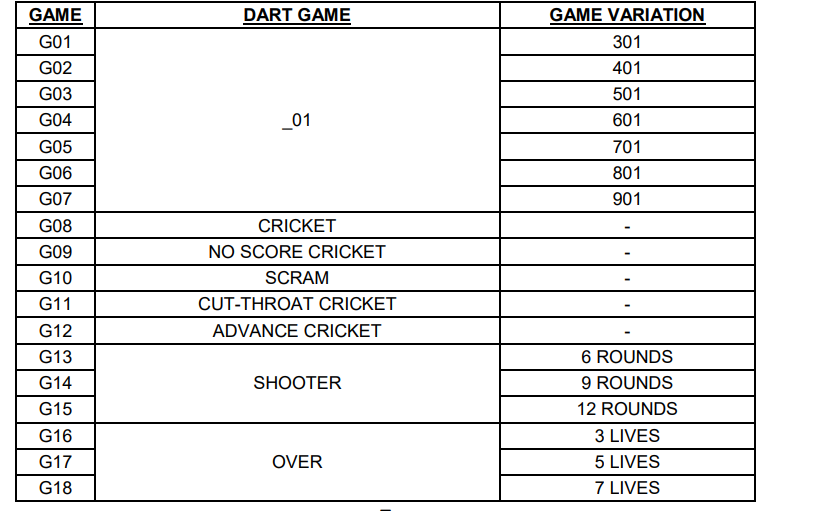
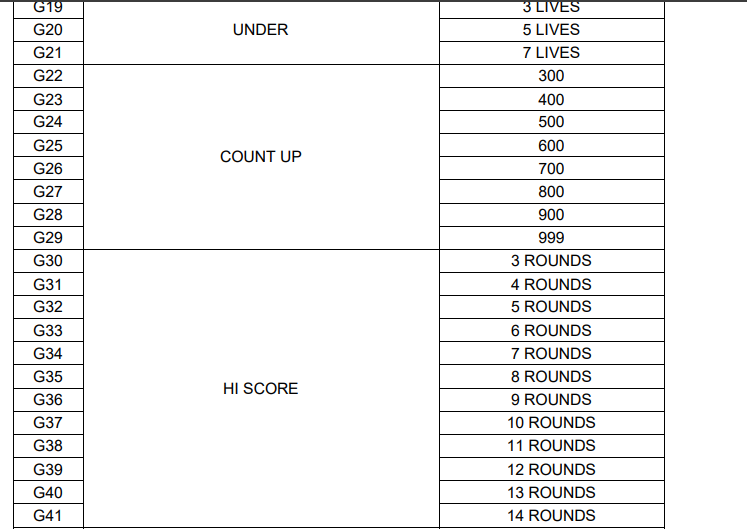
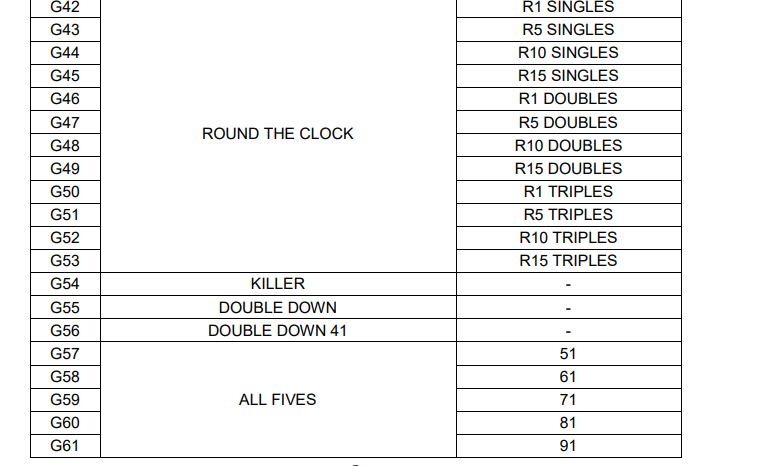
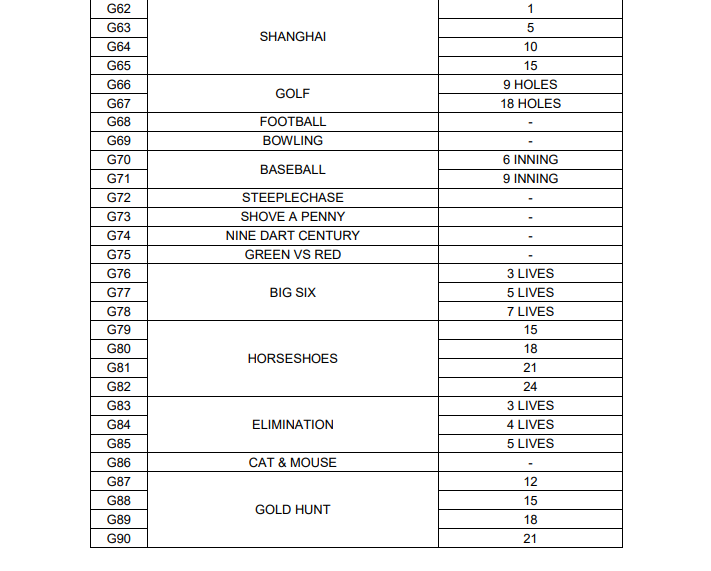
GAME INSTRUCTIONS
This popular tournament and pub game is played by subtracting each dart from the starting number (301) until the player reaches exactly 0 (zero). If a player goes past zero it is considered a “Bust” and the score returns to where it was at the start of that round. For example, if a player needs a 32 to finish the game and he/she hits a 20, 8, and 10 (totals 38), the score goes back to 32 for the next round. In playing the game, the double in / double out option can be chosen (double out is the most widely used option).
- Double In A double must be hit before points are subtracted from the total. In other words, a player‟s scoring does not begin until a double is hit.
- Double Out A double must be hit to end the game. This means that an even number is necessary to finish the game.
- Double In and Double Out A double is required to start and end scoring of the game by each player.
Another variations is listed below: - 401 Starting number 401
- 701 Starting number 701
- 501 Starting number 501
- 801 Starting number 801
- 601 Starting number 601
- 901 Starting number 901
CRICKET
Cricket is a strategic game for accomplished players and beginners alike. Players throw for numbers best suited for them and can force opponents to throw for numbers not as suitable for them. The object of Cricket is to “close” all of the appropriate numbers before one‟s opponent while racking up the highest number of points. Only the numbers 15 through 20 and the inner/outer bullseye are used. Each player must hit a number 3 times to “open” that segment for scoring (Refer to Tournament Cricket Scoring section for explanation on how players‟ marks are registered).
A player is then awarded the number of points of the “open” segment each time he/she throws a dart that lands in that segment, provided their opponent has not closed that segment. Hitting the double ring counts as two hits, and the triple ring counts as 3 hits. Numbers can be opened or closed in any order. A number is “closed” when the other player(s) hit the open segment 3 times. Once a number has been “closed”, any player for the remainder of the game can no longer score on it.
Winning The side closing all the numbers first and accumulating the highest point total is the winner. If a player “closes” all numbers first but is behind in points, he/she must continue to score on the “open” numbers. If the player does not make up the point deficit before the opposing player(s) “closes” all the numbers, the opposing side wins. Play continues until all segments are closed – the winner is the player with the highest score.
Cricket Scoring Display
This dartboard utilizes a dedicated scoreboard within the scoring display that keeps track of each player‟s segment status when playing Cricket. When Cricket is selected, individual characters will be utilized to register marks. There are 3 separate lights within each number (15 through 20 and bullseye). During play, one of the status lights will turn on (black will appear) as a segment is hit. If a double or triple of an active number is hit, 2 or 3 lights will turn on respectively.
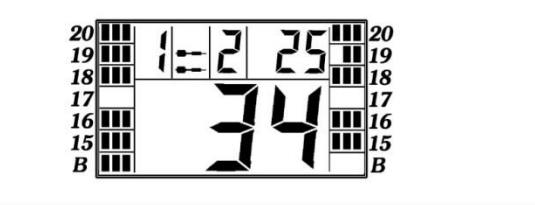
NO-SCORE CRICKET
Same rules as standard Cricket except there is no point scoring. The object of this version is to be the first to simply “close” all the appropriate numbers (15 through 20 and the bullseye).
SCRAM (For 2 players only)
This game is a variation of Cricket. The game consists of two rounds. The players have a different objective in each round. In round 1, player 1 tries to “close” (score 3 hits in each segment – 15 to 20 and bullseye). During this time, player 2 attempts to rack up as many points in the segments that the other player has not yet closed. Once player 1 has closed all segments, round 1 is complete. In round 2, each player‟s roles are reversed. Now, player 2 tries to close all the segments while player 1 goes for points. The game is over when round 2 is complete (player 2 closes all segments). The player with the highest point total is the winner.
CUT-THROAT CRICKET
Same basic rules as standard Cricket except once scoring begins, points are added to your opponent(s) total. The object of this game is to end up with the fewest points. This variation of Cricket offers a different psychology to the players. Rather than adding to your own score and helping your own cause as in standard Cricket, Cut-Throat offers the benefit of racking up points for your opponent(s), digging him in a deeper hole. Competitive players will love this
variation!
ADVANCED CRICKET
This difficult version of cricket was developed for the advanced player. Players must close out the segments (20,19,18,17,16,15 and bullseye) by using only triples and doubles! In this challenging game, doubles segments count as 1x the number, and triple segments count as 2x the number. The bullseye scoring is the same as in standard cricket. The first player to close out the numbers with the most points is the winner.
SHOOTER
This challenging game tests the players ability to “group together” darts within a segment during each round of play. The computer will randomly select the segment the players must shoot for at the start of each round – indicated by a flashing number in the display. Scoring is as follows: Single segment = 1 Point Double segment = 2 Points Triple segment = 3 Points Single Bullseye= 4 Points. When the computer selects players to hit double Bullseye, the outer bull scores 2 points and the inner Bull scores 4 points. The player with the most points at the end of the rounds is the
winner.
OVERS
The object of this game is to simply score higher (“over”) than your own previous three dart total score. Before play begins, players choose the amount of lives to be used by pressing the SELECT button. When a player fails to score “over “ their previous three-dart total, they will lose one life. When a player “equals” the previous three dart total, a life will also be lost. The LED screen on the right will light up once for each life taken away. The last player with a life
remaining is the winner.
UNDERS
This game is the opposite of “Overs” Players must score less (“Under”) than their own previous three-dart total. The game begins with 180 (highest total possible) when the player shoots higher than his or her own previous three-dart total, they will lose a life. Each dart that hits outside the scoring area, including bounce outs will be penalized with 6o points added to your score. The last player with a life remaining is the winner.
ROUND – THE – CLOCK
ROUND – THE – CLOCK – R1 singles
Each player attempts to score in each number from 1 through 20 and bullseye in order. Each player throws 3 darts per turn. If a correct number is hit, he/she tries for the next number in sequence. The first player to reach 20 is the winner. The display will indicate which segment you are shooting for. A player must continue shooting for a segment until it is hit. The display will then indicate the next segment you should shoot for. There are many difficulty settings available for this game. Each game has the same rules, the differences are detailed as follows:
- ROUND-THE-CLOCK 5 – Game starts at segment number 5
- ROUND-THE-CLOCK 10 – Game starts at segment number 10
- ROUND-THE-CLOCK 15 – Game starts at segment number 15
Since this game does not utilize point scoring, the double and triple rings count as single numbers. We have added some additional levels of difficulty to this game for those looking for a real challenge!:
ROUND-THE-CLOCK Double Player must score a Double in each segment from 1 through 20 in order.
- ROUND-THE-CLOCK Double 5 Game starts at double segment 5
- ROUND-THE-CLOCK Double 10 Game starts at double segment 10
- ROUND-THE-CLOCK Double 15 Game starts at double segment 15
ROUND-THE-CLOCK Triple Player must score a Triple in each segment from 1 through 20 in order
- ROUND-THE-CLOCK Triple 5 – Game starts at triple segment 5
- ROUND-THE-CLOCK Triple 10 – Game starts at triple segment 10
- ROUND-THE-CLOCK Triple 15 – Game starts at triple segment 15
KILLER
This game will really show who your friends are. The game can be played with as few as two players, but the excitement and challenge builds with even more players. To start, each player must select his number by throwing a dart at the target area. The LCD display will indicate “SEL” at this point. The number each player gets is his assigned number throughout the game. No two players can have the same number. Once each player has a number, the action starts. Your first objective is to establish yourself as a “Killer” by hitting the double segment of your number. Once your double is hit, you are a “Killer” for the rest of the game. Now, your objective is to “kill” your opponents by hitting their segment number until all their “lives” are lost. The last player to remain with lives is declared the winner. It is not uncommon for players to “team up” and go after the better player to knock him out of the game.
DOUBLE DOWN
Each player starts the game with 40 points. The object is to score as many hits in the activesegment of the current round. The first round, the player must throw for the 15 segment. If no15‟s are hit, his score is cut in half. If some 15‟s are hit, each 15 (doubles and triples count) is added to the starting total. The next round players throw for the 16. Segment and hits are added to the new cumulative point total. Again, if no hits are registered, the point total is cut in half. Each player throws for the numbers as indicated in the chart below in order (the LCD screen will indicate the active segment in which to throw). The player who completes the game with the most points is the winner

DOUBLE DOWN 41
This game follows similar rules as standard Double Down as described above with two exceptions. First, instead of going from 15 through 20 and bullseye, the sequence is reversed which will be indicated on the LCD display. Second, an additional round is included toward the end in which players must attempt to score three hits that add up to 41 points (20, 20, 1;19, 19, 3; D10, D10, 1: etc.). This “41” round adds an extra level of difficulty to the game Remember, a player‟s score is cut in half if not successful, so the “41” round presents quite a challenge

For more manuals by Accudart, visit ManualsLibraryy
Accudart eX3000 Electronic Dartboard Game-FAQs
How does the dartboard scoring system work?
Bullseye (center): 50 points
Outer bull (ring around bullseye): 25 points
Double ring (outer thin ring): Double the segment’s points
Triple ring (inner thin ring): Triple the segment’s points
Standard segments: Score their marked value (1–20)
Winning: Reduce score to exactly zero, finishing on a double or bullseye.
What’s the correct height and distance for an electronic dartboard?
Height: 5 feet 8 inches (1.73m) from floor to bullseye center.
Throwing distance (oche): 8 feet (2.44m) from board face to toe line.
How does an electronic dartboard work?
Uses soft-tip darts (safer for home use).
Automatically detects hits and calculates scores.
Features multiple game modes (e.g., 301, 501, Cricket).
Some models allow steel-tip darts with a magnetizer.
What are the different types of dart points?
Soft-tip darts: Used on electronic boards (plastic tips).
Steel-tip darts: For traditional bristle boards.
Conversion points: Let steel-tip darts work on electronic boards.
What are the basic rules of darts?
Players take turns throwing 3 darts per round.
Stand behind the throwing line (oche).
Start with 301 or 501 points, subtracting each dart’s score.
Must finish on a double or bullseye.
Why should I rotate my dartboard?
Prevents uneven wear in high-use segments (e.g., 20, bullseye).
Extends the board’s lifespan.
Rotate weekly for casual play, daily for heavy use.
How do I maintain my electronic dartboard?
Clean regularly with a soft, dry cloth (no water or chemicals).
Remove darts gently (no twisting to avoid damage).
Store in a dry place to prevent moisture damage.
How do I stop my dartboard from moving?
Tighten the center screw on the back.
Ensure the mounting bracket is secure.
Use a dartboard surround for extra stability.

